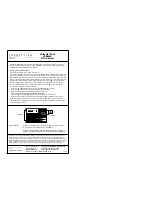
D
Pocket beep operation
This function uses subaudible tones for calling and can be
used as a “common pager” to inform you that someone has
called while you were away from the transceiver.
➀
Set the operating frequency.
➁
Set the desired subaudible tone (same as that used for
tone squelch operation, “CT”) in set mode.
• See p. 21 for programming.
➂
Push [TONE] two times until “TSQL
S
” appears.
➃
When a signal with a matched tone is received, the trans-
ceiver emits beep tones for 30 sec. and flashes “
S
.”
➄
Push [PTT] to answer or push [VFO] to stop the beeps and
flashing.
• Tone squelch is automatically selected.
D
Calling a waiting station using pocket beep
A subaudible tone matched with the station’s tone frequency
is necessary. Use the tone squelch on p. 21 or a subaudible
tone encoder.
4
ADVANCED FUNCTIONS
22
D
Tone scan
The transceiver can detect the subaudible tone frequency in a
received signal. By monitoring a signal, such as that being
transmitted on a repeater input frequency, you can determine
the tone frequency required to access the repeater.
➀
Set the desired frequency or memory channel to be
checked for a tone frequency.
➁
Push [T SCAN] for 1 sec. to start the tone scan.
• To change the scanning direction, rotate [DIAL].
➂
When the tone frequency is decoded, the set mode con-
tents are programmed with the tone frequency.
• The decoded tone frequency is used for the tone encoder or tone
encoder/decoder, depending on the the tone squelch ON/OFF
setting.
• “CT” or “rT” appears during tone scan when the tone squelch is in
use or not, respectively.
➃
Push [VFO] to stop the scan.
T
T
SQL
“CT” appears during
tone scan with tone squelch
Subaudible tone
frequencies flash as
they are scanned.
“rT” appears during tone scan
without tone squelch.











































